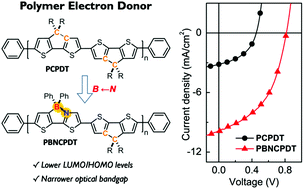Development of a donor polymer using a B ← N unit for suitable LUMO/HOMO energy levels and improved photovoltaic performance†
Abstract
The LUMO/HOMO energy levels of conjugated polymers are key parameters for their applications as polymer electron donors for polymer solar cells (PSCs). The widely-used strategy to tune the LUMO/HOMO levels of polymer donors is to develop D–A type polymers based on an alternating electron-donating unit (D) and an electron-accepting unit (A). In this paper, we report a novel approach to tune the LUMO/HOMO levels of polymer donors via replacing a C–C unit by a B ← N unit for enhanced PSC device performance. The control polymer PCPDT shows the LUMO/HOMO levels of −2.71 eV/−4.98 eV, which are both much higher than those required for an ideal polymer donor. By replacing a C–C unit with a B ← N unit, the resulting polymer PBNCPDT exhibits much lower LUMO/HOMO levels of −3.23 eV/−5.20 eV. PBNCPDT also shows a narrower optical bandgap (Eg = 1.73 eV) than that (Eg = 1.85 eV) of PCPDT, which is helpful for harvesting of sunlight. Moreover, PBNCPDT with the B ← N unit is not a typical D–A type conjugated polymer because its LUMO and HOMO are both delocalized over the whole conjugated framework. As the control PSC device based on PCPDT exhibits an open-circuit voltage (Voc) of 0.45 V and power conversion efficiency (PCE) of 0.63%, the device of PBNCPDT shows much improved Voc of 0.82 V and PCE of 3.74%. These results indicate that a B ← N unit can be used to develop polymer donors for high-performance PSC devices.


 Please wait while we load your content...
Please wait while we load your content...